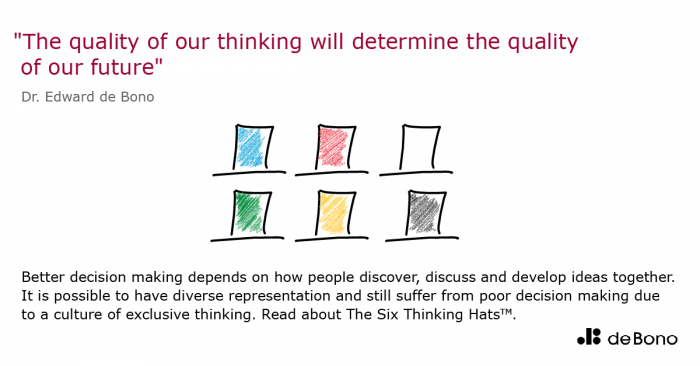
Companies are pursuing diversity and inclusion objectives to ensure a workforce that represents society and to enable better decision making. A principle of inclusion is to respect and value diversity in representation. Better decision making also depends on how people discover, discuss and develop ideas together. How meetings are run. It is possible to have diverse representation and still suffer from poor decision making due to a culture of exclusive thinking. Inclusive thinking is more than giving everyone an equal say. It requires an understanding of the modes of thinking that are used in meetings and how the meeting is structured. Inclusive meetings use a mechanism that respects and values diversity of ideas and makes for better decision making as those ideas are more fully explored.
The characteristics of exclusive meetings
-
A few people and or ideas dominate.
-
Argument is used as the main way to progress discussion.
-
Participants use their intelligence and experience to demonstrate that the idea they favour is the right one and that alternative ideas are weaker.
-
The discussion becomes narrower and more specific, each side seeking the special circumstances that gives their point of view the greatest weight.
-
One of these six modes of thinking can dominate the discussion to the exclusion of the other five:
-
There is a search for certainty with a focus on evidence. Any proposal has to be verified. There is no discussion of unverified possibilities and a paralysis of analysis results in the search for certainty.
-
Personal opinions dominate and how people feel or perceive others will feel determines the outcomes.
-
Only the benefits of the situation are considered. Everything is going to be wonderful, all problems have a silver lining. There is denial about the risks or issues.
-
If it can go wrong, it will go wrong. The focus is only on the issues, risks and problems.
-
The discussion goes in many different directions, exploring many possible alternatives, abandoning half developed ideas and including ideas that are not relevant to the agenda.
-
The person chairing the meeting dominates the discussion and only steers the conversation to his or her agenda. Most of the dialogue is between this person and one person at a time. The same can happen with the person of greatest authority at the meeting or the person controlling the mechanics of the meeting, for example writing on a flip chart or collaboration board.
The characteristics of inclusive meetings
-
There is a diversity of experiences, points of view and ideas expressed.
-
Parallel thinking is used to explore and develop the subject. Parallel thinking is when all the participants use the same mode of thinking at the same time. The emphasis is on exploring and developing ideas, not on owning your own idea and beating your opponents ideas.
-
Participants use their intelligence and experience to contribute to the development of all ideas not just the ones they initiate or favour.
-
The discussion is broad and considers many alternatives.
-
Each of the six modes of thinking are used in a balanced way. All the participants in the meeting use the same mode of thinking at the same time. The modes of thinking are then structured sequentially to create more balance. How to do this well requires some training.
-
There is a balance between using evidence to reduce uncertainty and creativity to generate new possibilities. Hypotheses or hunches are welcomed in order to open up exploration.
-
Opinions and feelings are welcomed and recognised as a valuable input. They are recognised as subjective points of view and therefore likely to be different based on different experiences. They are balanced with objective evidence where possible.
-
The benefits and the risks are evaluated in equal measure.
-
Creativity is given a specific focus and ideas are evaluated and developed in a structured way, seeking to amplify the strengths and mitigate the weaknesses.
-
The nature of the thinking in the meeting has a language that everyone can use. This allows the participants to be responsible for how the meeting operates not just the content of the meeting.
The outcomes are motivated participants, more constructive contributions and better informed decisions. The meetings are more productive in that the outcomes achieved are greater for the time invested. Often this also means shorter meetings.
This method of parallel thinking is called the Six Thinking Hats. It was created by Dr. Edward de Bono. It is a simple language for organising and enabling inclusive meetings and better decision making. Teams use this to solve complex, contentious issues, effectively and quickly. It is achieved without defeating ideas or people. The approach is not about consensus and compromise but about a genuine exploration of the topic without taking sides. It is a method for creating value and encouraging people to change their own minds.
Dr Edward de Bono’s methods have been adopted through training programs by organisations around the world since 1991. Our global network includes certified trainers and facilitators in 72 countries through 18 training partners. We provide in person and virtual training and facilitation, supported by interactive digital courses and applications. We help you apply the methods to topics that are important to you. Our training partners can also organise the certification of in-house and independent trainers. All training partners offer corporate training, some distributors also provide public seminars.
Talk to us about your requirements so we can tailor our solution to your needs. McLuhan & Davies Communications is a licensed distributor of de Bono Six Thinking Hats® training in Canada, the US, Caribbean, and Bermuda.
Republished under license from the copyright holder deBono.com. Find out more about the Six Thinking Hats™.
_ _ _ _ _ _ _ _ _

